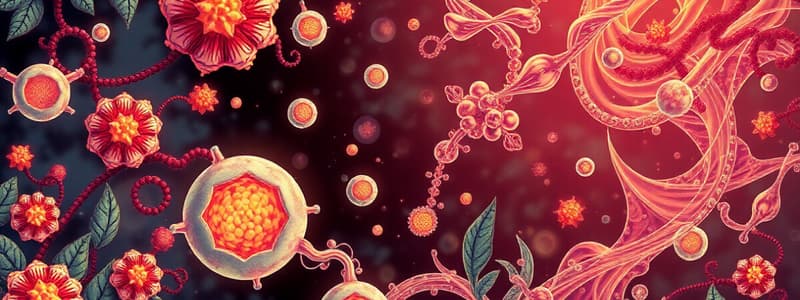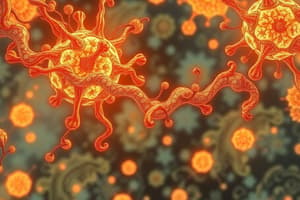Podcast
Questions and Answers
What is the primary cause of denaturation in enzymes?
What is the primary cause of denaturation in enzymes?
- High substrate concentration
- Alteration in enzyme shape
- Changes in temperature (correct)
- Increased enzyme concentration
What happens to enzyme activity when substrate concentration is increased up to a certain point?
What happens to enzyme activity when substrate concentration is increased up to a certain point?
- It initially increases. (correct)
- It becomes zero.
- It remains constant.
- It decreases significantly.
Which of the following statements about enzyme optimal conditions is true?
Which of the following statements about enzyme optimal conditions is true?
- Deviations from optimal conditions cause denaturation. (correct)
- Enzymes function best at extreme temperatures.
- All enzymes have the same optimal temperature.
- Optimal pH is the same for all substrates.
What role do proteins play as enzymes in biological processes?
What role do proteins play as enzymes in biological processes?
What percentage of DNA is categorized as 'junk' DNA?
What percentage of DNA is categorized as 'junk' DNA?
What amino acid would correspond to the RNA codon 'AAA'?
What amino acid would correspond to the RNA codon 'AAA'?
Which amino acid is represented by the codon 'GCC'?
Which amino acid is represented by the codon 'GCC'?
What is the product of the codon 'UGC'?
What is the product of the codon 'UGC'?
Which of the following codons will result in a 'STOP' signal?
Which of the following codons will result in a 'STOP' signal?
What amino acid does the RNA codon 'GAA' correspond to?
What amino acid does the RNA codon 'GAA' correspond to?
What is the role of mRNA in the process of translation?
What is the role of mRNA in the process of translation?
What is the significance of the START codon during protein synthesis?
What is the significance of the START codon during protein synthesis?
What does the term 'gene mutation' refer to?
What does the term 'gene mutation' refer to?
What is the relationship between codons and amino acids?
What is the relationship between codons and amino acids?
What is the function of tRNA in the translation process?
What is the function of tRNA in the translation process?
What function do enzymes serve in the human body?
What function do enzymes serve in the human body?
How would an increase in temperature above an enzyme's optimum temperature likely affect its activity?
How would an increase in temperature above an enzyme's optimum temperature likely affect its activity?
What is the primary role of the active site in an enzyme?
What is the primary role of the active site in an enzyme?
What happens to enzyme activity when the surrounding pH deviates from its optimum level?
What happens to enzyme activity when the surrounding pH deviates from its optimum level?
Identify the amino acid corresponding to the RNA codon 'AAA'.
Identify the amino acid corresponding to the RNA codon 'AAA'.
Which amino acid does the codon 'GCC' translate to?
Which amino acid does the codon 'GCC' translate to?
What is the primary function of the enzyme endolysin as described in the provided information?
What is the primary function of the enzyme endolysin as described in the provided information?
What is the translation result of the RNA codon 'UGC'?
What is the translation result of the RNA codon 'UGC'?
Which of the following accurately describes the composition of proteins?
Which of the following accurately describes the composition of proteins?
Which amino acid corresponds to the codon 'UUA'?
Which amino acid corresponds to the codon 'UUA'?
How would a decrease in temperature below an enzyme's optimum temperature affect its activity?
How would a decrease in temperature below an enzyme's optimum temperature affect its activity?
What does the codon 'UAA' represent in the RNA sequence?
What does the codon 'UAA' represent in the RNA sequence?
What is the significance of the active site in an enzyme?
What is the significance of the active site in an enzyme?
Which statement best describes enzyme-substrate specificity?
Which statement best describes enzyme-substrate specificity?
What is the function of transfer RNA (tRNA) in protein synthesis?
What is the function of transfer RNA (tRNA) in protein synthesis?
Which description best encapsulates the role of codons in the genetic code?
Which description best encapsulates the role of codons in the genetic code?
What initiates the process of translation in protein synthesis?
What initiates the process of translation in protein synthesis?
What happens when the ribosome reaches a STOP codon during translation?
What happens when the ribosome reaches a STOP codon during translation?
Which statement accurately describes the process of gene mutation?
Which statement accurately describes the process of gene mutation?
What is the primary consequence of extreme deviations from an enzyme's optimal pH?
What is the primary consequence of extreme deviations from an enzyme's optimal pH?
Which statements accurately describe the effects of temperature on enzyme activity?
Which statements accurately describe the effects of temperature on enzyme activity?
What defines the optimal substrate concentration for enzyme activity?
What defines the optimal substrate concentration for enzyme activity?
What roles do proteins play as part of the immune system in vertebrates?
What roles do proteins play as part of the immune system in vertebrates?
What percentage of human DNA is classified as non-coding DNA, and what are its functions?
What percentage of human DNA is classified as non-coding DNA, and what are its functions?
Flashcards
What are enzymes?
What are enzymes?
Enzymes are proteins that speed up chemical reactions by lowering the activation energy required for the reaction to occur.
What is the active site of an enzyme?
What is the active site of an enzyme?
The active site is the specific region on an enzyme where the substrate binds. The shape of the active site is complementary to the shape of the substrate, like a lock and key.
Explain enzyme-substrate specificity.
Explain enzyme-substrate specificity.
Enzyme-substrate specificity refers to the fact that each enzyme interacts with only a specific type of substrate. This is due to the precise fit between the active site of the enzyme and the shape of the substrate.
Describe the structure of proteins.
Describe the structure of proteins.
Signup and view all the flashcards
What is endolysin?
What is endolysin?
Signup and view all the flashcards
What is denaturation?
What is denaturation?
Signup and view all the flashcards
How does temperature affect enzyme activity?
How does temperature affect enzyme activity?
Signup and view all the flashcards
How does pH affect enzyme activity?
How does pH affect enzyme activity?
Signup and view all the flashcards
How does substrate concentration affect enzyme activity?
How does substrate concentration affect enzyme activity?
Signup and view all the flashcards
What are some functions of proteins?
What are some functions of proteins?
Signup and view all the flashcards
What is the genetic code?
What is the genetic code?
Signup and view all the flashcards
What is translation?
What is translation?
Signup and view all the flashcards
What is a ribosome?
What is a ribosome?
Signup and view all the flashcards
What is the role of tRNA?
What is the role of tRNA?
Signup and view all the flashcards
What is a mutation?
What is a mutation?
Signup and view all the flashcards
What is a codon?
What is a codon?
Signup and view all the flashcards
What is degeneracy in the genetic code?
What is degeneracy in the genetic code?
Signup and view all the flashcards
What is the start codon?
What is the start codon?
Signup and view all the flashcards
What are ribosomes?
What are ribosomes?
Signup and view all the flashcards
What is the function of tRNA?
What is the function of tRNA?
Signup and view all the flashcards
What is protein denaturation?
What is protein denaturation?
Signup and view all the flashcards
Study Notes
Enzymes 1.7.25
- Enzymes are globular proteins that act as biological catalysts
- Catalysts speed up chemical reactions by lowering the activation energy needed for the reaction to occur.
- A molecule that interacts with an enzyme is likely a substrate
- Enzymes have a specific role in the human body. Examples include lactase breaking down lactose.
- High fever (105°F) can denature enzymes, reducing their activity
Effects of Temperature, pH, and Substrate Concentration on Enzyme Activity
- Each enzyme has an optimum temperature at which it functions most effectively
- Increasing temperature above the optimum causes enzyme denaturation
- Decreasing the temperature reduces the collisions between enzyme and substrate molecules, thus decreasing the reaction rate.
- Each enzyme has an optimum pH range
- Deviations from the optimum pH leads to enzyme denaturation
- Initially increases in substrate concentration will increase enzyme activity, but once the substrates are saturated, additional substrate concentrations do not increase the reaction rate further.
Harmless Skin Virus Fights Acne
- Acne occurs when hair follicles become blocked with sebum
- Bacteria, such as Propionibacterium acnes, can contaminate and infect the plugged follicles.
- Phage viruses appear to help reduce acne by targeting and destroying specific bacteria using endolysin.
- A protein called endolysin destroys bacteria by breaking down their cell walls.
- Phages are programmed to target only specific bacteria, unlike antibiotics that kill many types of bacteria.
Proteins
- Proteins are chains of amino acids
- The structure of proteins determines their function
- Enzymes are proteins that catalyze biochemical reactions
- The active site is the location on an enzyme where a substrate binds
- Enzyme-substrate specificity means the active site of each enzyme has a shape that matches the shape(s) of a specific substrate(s).
Denaturation
- Denaturation is a structural change in a protein that causes a loss of its biological properties.
- Changes in temperature and pH are some causes of protein denaturation
Outline the Range of Functions of Proteins
-
Proteins act as enzymes, biological catalysts
-
Examples include lactase, which breaks down lactose into galactose and glucose
-
Proteins act as hormones: Chemical Messengers
-
Example Insulin signals the uptake of sugar from the blood stream into the liver cells
-
Proteins act as cell receptors
-
Example Insulin Receptors in liver cells
-
Proteins assist the immune system
-
Example antibodies recognizes pathogens
-
Proteins form structural components in tissues
-
Example Collagen is the main structural protein in connective tissues between bones.
Outline the Organization of Human DNA
- Coding DNA contains instructions to build proteins
- Non-coding DNA regulates the transcription of genes
- 'Junk DNA' has no known function.
Outline the Evidence for Evolution
- Fossils are the preserved remains of ancient organisms
- Fossils evidence changes in organisms over time
- Fossil evidence includes bone structures, impressions in rock, remains in amber, and ancient pollen grains
- Domesticated plants and animals demonstrate selective breeding to produce specific traits
- Homologous structures have similar underlying structures, but different functions, suggesting a common ancestor
- DNA sequence comparisons can determine evolutionary relationships based on shared nucleotides or differences in their sequences and lengths
Describe the genetic code
- The Genetic Code is a system allowing cells to translate information from nucleic acids (DNA and RNA) into proteins.
- Three RNA Nucleotides form a codon—each codon codes for one amino acid.
- Amino acid sequences form proteins.
Outline the Process of Translation Leading to Protein Formation
- mRNA molecules carry information stored in DNA.
- mRNA leaves the nucleus and travels to ribosomes in the cytoplasm.
- Each tRNA molecule carries a specific amino acid.
- Anticodons on the tRNA bind with complementary codons on the mRNA.
- Enzymes bond amino acids together to form a protein structure
- Translation stops at a STOP codon
Define Mutation
- A gene mutation is any change in the DNA base sequence of a gene
Nucleotides, DNA Replication, and Complementary Bases
- Nucleotides are the building blocks of DNA.
- Describes DNA Replication, using terms like template, enzyme and nucleotides.
- Complementary base pairs in DNA are: Adenine pairs with Thymine (A-T) and Guanine pairs with Cytosine (G-C)
Genetic Code and Codons
- A codon is three RNA bases that together code for one amino acid
- Translation of codons from a genetic code chart provides amino acid sequences (codon table provided)
Describe a gene
- A gene is a segment of DNA that contains the genetic information needed to produce a protein.
- It consists of a series of bases, A, C, T, G.
- The sequence of bases determines the sequence of amino acids in the protein they encode, and the shape and function of the resulting protein(enzymes, structural components etc.).
Define Trait, Heredity, Chromosome and Gene
- Traits are characteristics determined by genes
- Heredity is the transmission of genetic information from one generation to the next.
- Chromosomes are thread-like structures composed of DNA and proteins.
- Genes are segments of DNA that contain instructions for building proteins
Define DNA
- DNA, deoxyribonucleic acid, stores genetic information needed for heredity.
- It is composed of subunits called nucleotides
Explain how a DNA double helix is formed
- Two single strands of DNA form Hydrogen bonds between bases.
- Bases A & T and, G & C pair together.
- Once formed, it twist into a double helix shape.
Studying That Suits You
Use AI to generate personalized quizzes and flashcards to suit your learning preferences.



